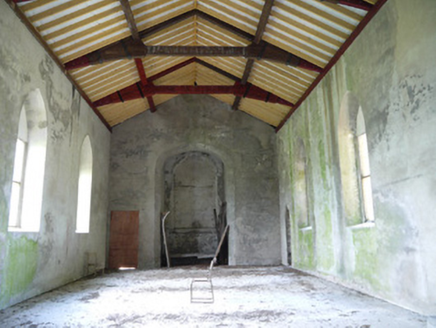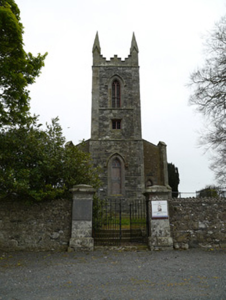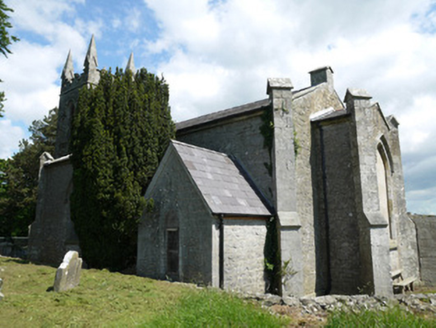Survey Data
Reg No
41402817
Rating
Regional
Categories of Special Interest
Architectural, Social
Original Use
Church/chapel
Date
1825 - 1830
Coordinates
285794, 306706
Date Recorded
11/06/2012
Date Updated
--/--/--
Description
Freestanding Board of First Fruits Gothick-style Church of Ireland church, built 1827, comprising four-bay nave with diminished chancel, vestry to south, and three-stage tower to west. Now derelict. Pitched natural slate roof with limestone verges and coping. Squared and snecked sandstone walls, with diagonal buttresses with saddle-backed coping. Tower has tooled quoins, string courses, and needle pinnacles to corners of crenellated parapet. Pointed-arch windows with painted timber frames, stop-ended hood-mouldings, splayed surrounds and flush sills, Y-tracery (mostly blocked up), Tower belfry stage louvred. Second stage of tower has square-headed bipartite casements with splayed surrounds. Pointed-arch entrance, similarly detailed, with painted timber moulded panelled double-leaf door with similar tympanum. Interior undergoing renovation. Tudor chancel arch, exposed timber roof structure having recent timber rafters, and rendered walls. Terracotta tiles to entrance porch, concrete floor elsewhere. Pointed-arch door openings with chamfered reveals from nave to entrance porch, and from nave to vestry, that to porch having timber panelled door. Situated within terraced boundary wall enclosing graveyard dotted with mature specimen trees. Wrought-iron double-leaf gate hinged to square-plan tooled limestone piers aligned in front of tower.
Appraisal
Saint Patrick's Church is set within its own graveyard, occupying a pleasant site that is enhanced by the privacy that is provided by its rubble stone boundary walls. Even though the building is now derelict it retains its original form and character. The coursed limestone walls with tooled limestone dressings are clearly the work of skilled craftsmen. The graveyard, with its early stone markers, encircles the church and is a site of historical and archaeological importance. The site is believed to be the burial place of poet Cathal Buí Mac Giolla Ghunna.





